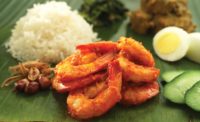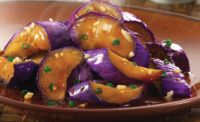DIY Asian
Asian food and beverage products are in high demand, and definitely on trend

SOURCE: Yuri Elkaim (www.yurielkaim.com)

Meeting the demand for do-it-yourself Asian cuisine is the growing availability of prepared simmer sauces, flavored broths, noodles or rice, and spice packets.
SOURCE: American Halal Company Inc. (www.saffronroadfood.com)

The popularity of South Asian cuisine in the US can be attributed in part to the expert renditions of its complex sauces in ready-to-use formats.
SOURCE: American Halal Co. Inc. (www.saffronroadfood.com)

Emerging food trends travel on adaptability to American preferences, like re-imagining popular Vietnamese lettuce wraps with good old American turkey.
SOURCE: Butterball LLC (www.butterballfoodservice.com)

Spice blends and flavored broths can take the complication out of replicating some of the complicated—and less familiar—seasonings that distinguish different Asian cuisines.
SOURCE: McCormick & Co. Inc. (www.mccormick.com)





Consumers are finding themselves with an ever-growing appetite for adventure when it comes to their food. Yet they also are finding themselves short on the time it takes to forage and build the food—fundamental experiences when cooking at home.
Meeting this demand is the growing availability of prepared simmer sauces, flavored broths, spice packets, and ready-to-heat accompaniments in the supermarket. Answering the call from the other side is a surge in meal kit home-delivery companies, such as Blue Apron Inc., Meez Meals LLC, and Hello Fresh AG.
What these modular meal concepts share is a distinct culinary shift to the East: Consumers are showing their adventurousness by requesting Asian culinary experiences from these sources. And not just any Asian, but more eclectic experiences, from pan-Asian “broth bowls” to Korean bulgogi to the classic Bangkok dish, pad Thai. South Asian cuisines, too, are having their moment in the limelight, with such recipes as Indian biryani and Malaysian Panang curry landing on dining tables.
Driving these trends is the fact that, while these cuisines are in high demand, they are not easy to make from scratch. Whether it is unfamiliarity with the finer details of their favorite foods, lack of time or skill, or just difficulty in finding the ingredients, consumers are turning to meal kits, bought or delivered, to satisfy their cravings for culinary exploration.
While these emerging and flourishing food trends are coming from Asia with the speed and sizzle of oil in a hot wok, chefs are enjoying the opportunity to flex their expertise and create the components that make it all happen. But for the creative research chef, a major portion of the process is all about sourcing the right ingredients.
The ingredients for these more exotic culinary creations must, above all, be authentic. For example, Thai Direct Inc., established last year, bills itself as “the first authentic Thai meal kit company...bringing authentic Thai fresh ingredients and best recipes.” The company stresses that, through its service, “all home chefs can cook homemade Thai meals and enjoy the authentic Thai food experience without the trouble of finding Thai ingredients, such as fish sauce, kaffir lime leaves, galangal, Thai chili peppers, Thai holy basil, etc., that are rarely available at typical supermarkets or grocery stores.”
Even for developers making the kits or components, genuine ingredients might not be readily available from a current vendor or distributor. It’s also possible that members of the purchasing department might not know what the ingredients are that are being requested of them.
To meet the challenge of creating “modular” Asian foods that meet consumer demands for authenticity, convenience, and flavor, experimentation and creative sourcing will be necessary. But it is here that interplay with other team members, colleagues, and ingredient suppliers can be of the highest value.
Sauces on Simmer
American Halal Co. Inc.’s Saffron Road Foods launched its line of pouched simmer sauces back in 2010. Converting authentic, intricate South and Southeast Asian cuisines to such a “heat and eat” format proved to be a significant challenge. Not many manufacturing plants for hot-fill pouches were available at that time because the category was still relatively new in the US. Once that hurdle was surmounted, sourcing some of the ingredients was difficult.
This was compounded by the fact that the plant that could perform the hot-filling of sauce pouches was under strict kosher supervision. In many cases, rare ingredients might only be available from small purveyors or foreign countries. Those purveyors might not have the resources or funds to undergo kosher (or halal or similar) supervision and certification.
For example, it was necessary to develop and manufacture such fundamental ingredients as red and green Thai curry pastes from scratch instead of using purchased versions. In recreating many of these formulas stateside, the bar is raised to adhere to authenticity in the absence of the right regional ingredients.
In classic Thai curries, coconut milk is a key component. However, true Thai food is not typically overly “coconutty”, that is, the coconut flavor is delicately balanced with a careful ménage of leaves, roots, and spices. These ingredients elevate the experience beyond mere formulaic recipes.
Coriander, cumin, birds’ eye chili pepper; lemongrass, kaffir lime leaf, and galangal root engage in nuanced interplays of flavor and aroma. But, while these ingredients are readily available as dried ground powders, in Thailand they would be fresh.
This is where some careful workarounds can help. It is possible, for example, to build the galangal base pungency and tartness with ginger (a cousin of galangal), then accent that with the easy-to-acquire galangal powder. The latter will provide the key resin-like high notes.
By the same token, a kaffir lime base pungency and tartness can start with lime juice that is enhanced with kaffir lime leaf powder. Fresh lemongrass has become far more available in just the past few years, but if necessary, chefs may use it in puréed form. Still, as a last resort, it is possible to build the basic tartness with lemon juice and add the characteristic earthy flavor notes with lemongrass powder.
Fish sauce, too, has become common enough to source easily. But it also presents allergen issues. In this case, a dry tamari powder will work as well. Nori powder can be included in minute amounts to bring that seafood-like umami note back into the picture.
Tamarind is also an essential component of certain Thai dishes, especially a proper pad Thai. Fortunately, since many Mexican and Central American dishes also use tamarind, the paste is easy to get. However, quality varies greatly. Choose a tamarind paste that is moist, free of pits, has minimal fiber and is low in pH (high acid). The low pH will give it an improved shelflife plus drive the final flavor as well.
Korean Is Hot
Korean cuisine has become especially popular in the US of late. Pungent and spicy Gochujang sauce has been taking off as the “next sriracha.” The classic version is powdered Gochugaru chili pepper flakes, compounded with fermented soybean powder (known as mejukaru), plus a flour made from either sweet rice, brown rice, barley, or wheat and sweetened with rice syrup, barley malt syrup, and salt.
Another ingredient considered indispensable to authentic Korean cuisine is doenjang, a thick, fermented paste made from soybeans and brine. It adds just the right amount of umami and “twang” to a sauce or condiment.
In using this cornerstone of Korean cuisine (completely unfamiliar to US consumers a few years ago) for a simmer sauce, it now is possible to source the sauce itself from a number of purveyors. However, the Gochugaru pepper itself is critical to authenticity. Its fruity, somewhat musky-with-a-hint-of-tobacco notes are unique, and it is important to obtain it from a reputable vendor.
There are many versions of Gochugaru pepper available from China. However, these do not have the characteristic deep and earthy flavor notes of Korean peppers. The dried peppers have a shorter shelflife than most other dried peppers, so they should be purchased when needed or as close to when needed as possible. Another option is storing the peppers in vacuum packs in the freezer.
A suitable “Gochujang-like” sauce can be prepared by combining Gochugaru pepper, rice flour, and white miso. For a classic bulgogi preparation, use pear juice to build the fruit and sweet notes of this traditional sauce. Pear juice concentrate is best, in this case, because the concentration process keeps pH and brix predictable. These factors are extremely important when commercializing a simmer sauce in a shelf-stable pouch.
Liquid Gold
Nona Lim Kitchens LLC is deeply attuned to the DIY Asian ethos trending in the US. The company’s new Spicy Szechuan Bone Broth was directly inspired by Spices, a small but highly popular Szechuan restaurant in Oakland, California. The complicated and exotic flavors of the restaurant’s signature soups involve complex spices, multiple types of peppers in a single recipe, and truly unconventional ingredients, such as pig’s blood and pig’s stomach.
In creating its bone broth, Nona Lim strived for that same level of “wonderful complexity and punch,” but with the ingredients the company positions as the healthy foundation for accessible “everyday” meals. To accomplish this, the chefs started with an all-natural beef and chicken bone broth slowly simmered for 30 hours.
The challenge was to develop complex flavor in the slow-cooked broth using plant-based spices and vegetables. This included recreating it without turning to MSG, shellfish, fish sauce, or pork products.
The final formulations also used, depending on the product, many kinds of peppers, garlic, and Asian flavors, including mushrooms, lime juice, ginger, bay, white peppercorns, cinnamon, star anise, and cloves among others.
The company’s Vegan Miso Ramen Broth also needed to meet the challenge of attaining a meaty depth of flavor, yet without using any animal-based flavors. The result ended up employing ingredients such as seaweed, tahini, red miso, and sake in a vegetable broth. When combined with noodles or rice and fresh sliced veggies, it makes a fast and flavorful vegan lunch.
Marketing the broths as kits to serve with pad Thai noodles, bean sprouts, and choices of protein (such as pork belly or beef skewers) puts Nona Lim squarely in the center of the modular concept of DIY Asian cuisine. The company’s products are quick to prepare, full of flavor, and convenient as an easy lunch or dinner.

The ingredients for successful exotic culinary creations must, above all, be authentic. But putting it all together must be foolproof.
SOURCE: ThaiDirect Inc. (www.thaidirect.co)
Rice Noodles at the Ready
Another big DIY inspiration for the Nona Lim brand came in creating a line of gluten-free rice noodles. For these, Nona Lim turned to her youth in Singapore, a nation known for its dozens of noodle stalls lining the streets. These walk-up venues specialize in noodles for soups and stir-fries that are a lunchtime standard for
Singaporeans.
Paying homage to the traditional recipes but as gluten-free and non-GMO, Nona Lim Kitchens created a versatile line of Indonesian laksa, pad Thai and pad see ew rice noodles. Each of them can be prepared with just a one-minute blanch in boiling water, then added to broth or lightly sau-téed with Asian sauces, vegetables and/or protein. The result is a DIY Asian stir-fry in under five minutes. The noodles replicate the street-food level of convenience but are designed for home kitchens in the US.
Saffron Road recently teamed up with Nona Lim’s Kitchens to create a club-store version of its pad Thai frozen entrée for the refrigerated case. Rice noodles are delicate and usually have a short shelflife, which could have been a major concern. However, Nona Lim’s contribution to the collaboration was authentic, precooked noodles with a shelflife of more than 60 days.
The resulting meal kit consists of a pouch of fully cooked and ready-to-heat Nona Lim Pad Thai Noodles with a pouch of Saffron Road Pad Thai sauce (made with tamarind and fish sauce), plus a pouch of fully cooked boneless chicken. Also included are a pouch of fresh yellow soybean sprouts and carrots for garnish.
The noodles plump correctly when microwaved, while the sauce does not break and the chicken stays moist. All the consumer needs is a handful of crushed peanuts, and a true DIY Asian meal is on the table in under 15 minutes.
Originally appeared in the September, 2017 issue of Prepared Foods as DIY Asian.
Make Nice with Rice
Rice and rice noodles, a fundamental component of Asian cuisine, have undergone a revolution. But differentiation in these ingredients has only come recently to consumers. Leading this development is a special kind of rice from Thailand, the world leader in rice exports. Thai hom mali rice (also called Thai jasmine rice), a highly aromatic, medium-grain rice, adds an extra dimension to meals by imparting its own singular, yet non-intrusive flavor. Consumer awareness of the rice has led to increased demand for it by name, and processors are responding. For example, earlier this year Lundberg Family Farms Inc. worked with the Thai Organic & Fairtrade Agriculture Group and a select network of Thai rice farmers to bring organic, fair-trade, non-GMO Thai hom mali jasmine rice to the US in fast-prep heat & eat packets. The company offers brown jasmine and red jasmine varieties, as well as a special red and white blend.
Looking for a reprint of this article?
From high-res PDFs to custom plaques, order your copy today!












